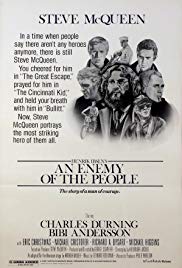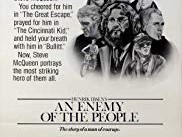An Enemy of the People ** (1978, Steve McQueen, Bibi Andersson, Charles Durning) – Classic Movie Review 9286
‘The water’s poisoned. The people are poisoned. The children are poisoned! The water is poisoned!’ – Dr Thomas Stockmann.
Ah yes, Steve McQueen versus Henrik Ibsen! Producer-director George Schaefer’s 1978 drama An Enemy of the People is an honourable but ill-conceived big-screen version of Arthur Miller’s stage adaptation of Henrik Ibsen’s classic 1883 play is a vanity project for then fading star Steve McQueen as Dr Thomas Stockmann, a late-19th century scientific doctor who is ostracised by his entire Norwegian village when he tries to proclaim his findings that the springs for their medicinal spa are polluted by factory effluent.
The lead character of a rabble-rousing, whistle-blowing early environmentalist is a memorable archetype, and the material is always pertinent and potent, but it is mishandled here in a version that seems far too talky, lecturing and strident. The static, hard-going film, under Schaefer’s uninspired direction, lacks subtlety, nuance, and light and shade throughout.
Charles Durning, (impressively bearded) as the doctor’s corrupt mayor brother Peter Stockmann, effortlessly gives an acting lesson to a buried-in-his-beard, glasses and long hair McQueen, who is way outside his comfort zone and unfortunately isn’t really up to the occasion.
Also in the cast are Bibi Andersson, Eric Christmas, Richard Dysart, Michael Cristofer, Robin Pearson Rose, Richard Bradford and Michael Higgins.
An Enemy of the People is directed by George Schaefer, runs 104 minutes, is made by First Artists and Solar Productions, is released by United Artists, is written by Alexander Jacobs (screenplay) and Arthur Miller (adaptation), based on Henrik Ibsen’s play, is shot in in Metrocolor by Paul Lohmann, is produced by Steve McQueen (executive producer) and George Schaefer, and is scored by Leonard Rosenman, with Production Design by Eugène Lourié.
McQueen agreed to take a union scale fee and promised to keep the cost less than $3 million to convince his obviously sceptical First Artists production partners to agree to make the film. The budget turned out to be $2,500,000.
It is shot in Metrocolor but the opening and end sequences are in black and white.
McQueen was in decline because he had not filmed in four years since The Towering Inferno (1974), apart from an uncredited cameo in Dixie Dynamite (1976). He made two other films, Tom Horn and The Hunter in 1980, just before his death on 7 (age 50) of lung cancer and a heart attack.
© Derek Winnert 2019 Classic Movie Review 9286
Check out more reviews on http://derekwinnert.com



